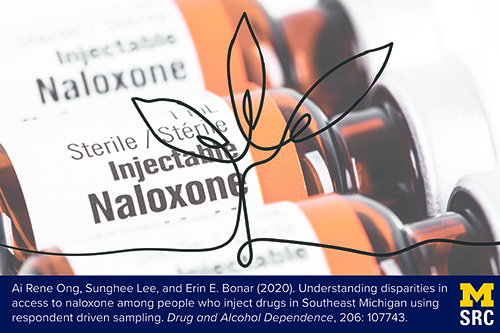May 11, 2020
Ong and Lee Leverage Data Collected Using Respondent Driven Sampling to Understand Disparities in Access to Naloxone among Injection Drug Users in Southeastern Michigan

Ai Rene Ong, who is a doctoral candidate in the Michigan Program in Survey Methodology and a research assistant in the Survey Methodology Program (SMP), recently collaborated with SMP faculty member Sunghee Lee and Dr. Erin Bonar from the University of Michigan Addiction Center to publish an original research investigation entitled 'Understanding disparities in access to naloxone among people who inject drugs in Southeast Michigan using respondent driven sampling' in the journal Drug and Alcohol Dependence. Naloxone is a critical, life-saving antidote for people who have overdosed on prescription opioids, which unfortunately is becoming much more common in today's society, especially among injection drug users. These high-risk populations are also harder to identify, sample, and measure, which is where respondent driven sampling (RDS), a technique that Dr. Lee specializes in, becomes so valuable.
This research team analyzed data collected as part of the project Positive Assessment Towards Health (PATH). In 2017, PATH recruited 46 seeds, who in this case were persons who inject drugs (PWID), to complete self-administered questionnaires and spread the word about this research project among their peers. The seeds, who received a $30 incentive for participating, were recruited from local agencies and community health clinics in Southeastern Michigan serving PWID. Following RDS techniques, the seeds were given three recruitment coupons and asked to recruit their PWID peers. Participants received $10 per successful recruit. PATH ultimately recruited a total of 410 PWID from Southeastern Michigan to participate in the study. The participants completed Audio Computer-Assisted Self-Administered Interviewer (ACASI) questionnaires at community and health centers. The questionnaires collected information on substance use behaviors and access to naloxone, among other related topics. The research team then computed descriptive statistics using weighted estimators appropriate for RDS (using the inverse of the self-reported network size as a weight), and fitted logit models to these data using the same weights, predicting self-reported naloxone access as a function of socio-demographics, health indicators, substance use history, and geographic information.
The authors found evidence of significant disparities in access as a function of geography (where urban individuals were much less likely to have access), race/ethnicity (where non-Hispanic blacks and those of other races/ethnicities had lower odds of having access relative to non-Hispanic whites), socio-economic status (e.g., access was substantially more likely for those with higher income), and recent homelessness (where those recently homeless were much more likely to have access). However, given the study sites (i.e. urban represented by Detroit), the geographical disparities in naloxone access may be due to the sociodemographic characteristics of these locations (i.e., a high proportion of non-Hispanic black PWID in Detroit). In addition, people with a history of prior opioid abuse were significantly more likely to have access. No age or gender differences were identified.
Overall, the results of this study suggest that access to naloxone among PWID, who are at high risk of opioid overdose, appears to be particularly low (an estimated 24.9% of individuals in this population have access), at least in Southeastern Michigan. Future work could certainly explore this issue in other communities to see if the same issues emerge elsewhere, and RDS is a promising technique for collecting these important data from these types of hard-to-reach populations. This work suggests that recent policies designed to increase naloxone access may not be entirely effective, especially for particularly high-risk subgroups, and the fact that RDS was able to shed light on this issue should be leveraged by substance abuse researchers from other communities in the future to better understand this important public health problem.
Ai Rene Ong, Sunghee Lee, and Erin E. Bonar (2020). Understanding disparities in access to naloxone among people who inject drugs in Southeast Michigan using respondent driven sampling. Drug and Alcohol Dependence, 206: 107743.